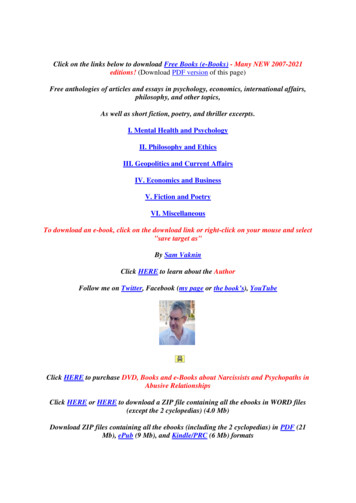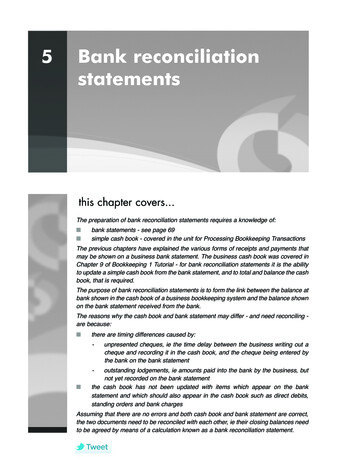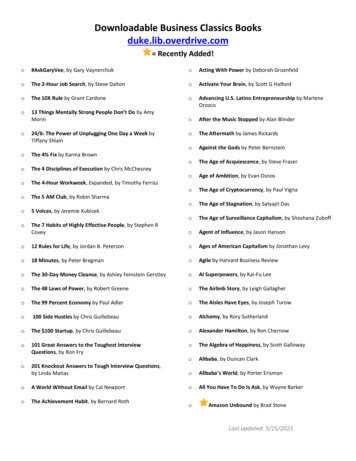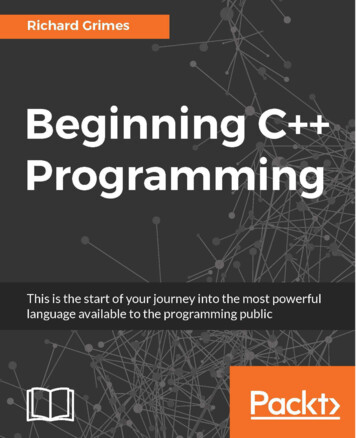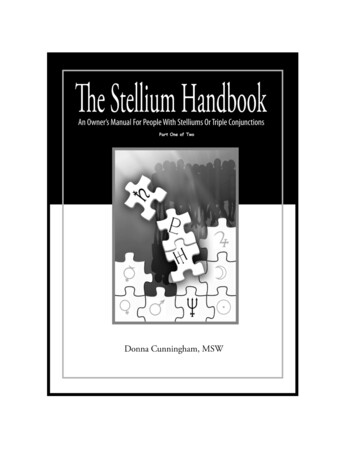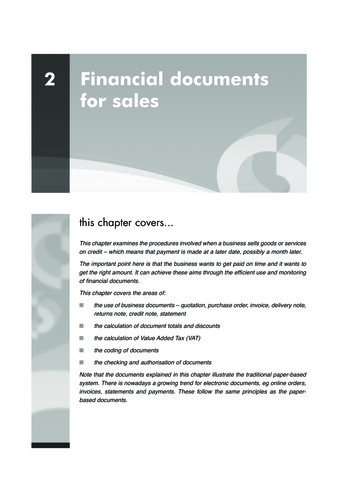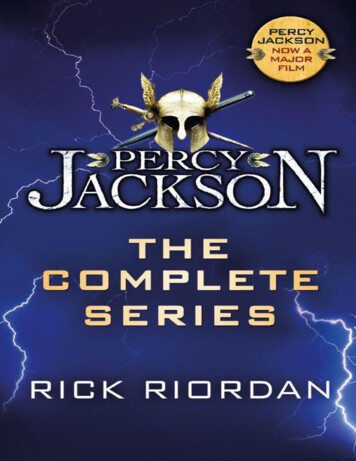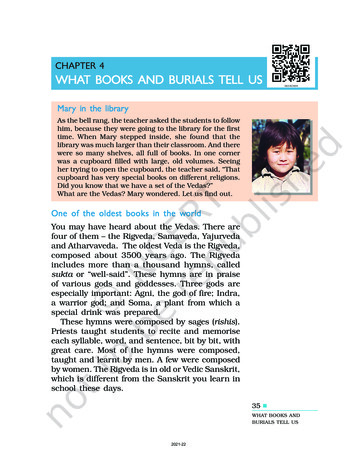
Transcription
CHAPTER 4WHAT BOOKWHATBOOKSS AND BURIALS TELL USMararMaryy in the librlibrararyyAs the bell rang, the teacher asked the students to followhim, because they were going to the library for the firsttime. When Mary stepped inside, she found that thelibrary was much larger than their classroom. And therewere so many shelves, all full of books. In one cornerwas a cupboard filled with large, old volumes. Seeingher trying to open the cupboard, the teacher said, “Thatcupboard has very special books on different religions.Did you know that we have a set of the Vedas?”What are the Vedas? Mary wondered. Let us find out.One of the oldest books in the worldworldYou may have heard about the Vedas. There arefour of them – the Rigveda, Samaveda, Yajurvedaand Atharvaveda. The oldest Veda is the Rigveda,composed about 3500 years ago. The Rigvedaincludes more than a thousand hymns, calledsukta or “well-said”. These hymns are in praiseof various gods and goddesses. Three gods areespecially important: Agni, the god of fire; Indra,a warrior god; and Soma, a plant from which aspecial drink was prepared.These hymns were composed by sages (rishis).Priests taught students to recite and memoriseeach syllable, word, and sentence, bit by bit, withgreat care. Most of the hymns were composed,taught and learnt by men. A few were composedby women. The Rigveda is in old or Vedic Sanskrit,which is different from the Sanskrit you learn inschool these days.35 nWHAT BOOKS ANDBURIALS TELL US2021-22
Sanskrit and other languagesSanskrit is part of a family of languages known as Indo-European.Some Indian languages such as Assamese, Gujarati, Hindi, Kashmiriand Sindhi; Asian languages such as Persian and many Europeanlanguages such as English, French, German, Greek, Italian andSpanish belong to this family. They are called a family because theyoriginally had words in common.Take the words ‘matr’ (Sanskrit), ‘ma’ (Hindi) and ‘mother’ (English).Do you notice any similarities?Other languages used in the subcontinent belong to differentfamilies. For instance, those used in the north-east belong to theTibeto-Burman family; Tamil, Telugu, Kannada and Malayalam belongto the Dravidian family; and the languages spoken in Jharkhand andparts of central India belong to the Austro-Asiatic family.List the languages you have heard about and try and identify thefamilies to which they belong.The books we use are written and printed. TheRigveda was recited and heard rather than read.It was written down several centuries after it wasfirst composed, and printed less than 200 yearsago.How historians study the RigvedaHowRigvedaHistorians, like archaeologists, find out about thepast, but, in addition to material remains, theyexamine written sources as well. Let us see howthey study the Rigveda.Some of the hymns in the Rigveda are in theform of dialogues. This is part of one such hymn,a dialogue between a sage named Vishvamitra,and two rivers, (Beas and Sutlej) that wereworshipped as goddesses.Find the rivers on Map 1 (page 2), then read on:n 36OUR PASTS–I2021-22
A page from amanuscript of theRigveda.This manuscript of theRigveda, on birch bark,was found in Kashmir.About 150 years ago, itwas used to prepare oneof the earliest printedtexts of the Rigveda, aswell as an Englishtranslation. It is nowpreserved in a library inPune, Maharashtra.ersVishvvamitramitraa and the RivRiversVishVishvamitra: O rivers, come down from the mountains like two swift horses, liketwo shining cows that lick their calves.You move like chariots to the sea, through the power of Indra. You are full ofwater and wish to unite with one another.The rivers: We, who are full of water, move along the path the gods have madefor us. Once we start flowing, we cannot be stopped. Why do you pray to us, osage?Vishvamitra: O sisters, please listen to me, the singer who has come from adistance with his chariots and carts. Let your waters not rise above our axles, sothat we can cross safely.The rivers: We will listen to your prayers so that you can cross safely.Historians point out that this hymn was composed in the area wherethese rivers flow. They also suggest that the sage lived in a society wherehorses and cows were valued animals. That is why the rivers are comparedto horses and cows.Do you think chariots were also important? Give reasons for your answer.Read the verses and find out what are the modes of transport that arementioned.Other rivers, especially the Indus and its other tributaries, and theSarasvati, are also named in the hymns. The Ganga and Yamuna arenamed only once.Look at Map 1 (page 2) and list 5 rivers that are not mentioned in theRigveda.37 nWHAT BOOKS ANDBURIALS TELL US2021-22
Cattle, horses and chariotsThere are many prayers in the Rigveda for cattle,children (especially sons), and horses. Horseswere yoked to chariots that were used in battles,which were fought to capture cattle. Battles werealso fought for land, which was important forpasture, and for growing hardy crops that ripenedquickly, such as barley. Some battles were foughtfor water, and to capture people.Some of the wealth that was obtained was keptby the leaders, some was given to the priests andthe rest was distributed amongst the people. Somewealth was used for the performance of yajnas orsacrifices in which offerings were made into thefire. These were meant for gods and goddesses.Offerings could include ghee, grain, and in somecases, animals.Most men took part in these wars. There wasno regular army, but there were assemblies wherepeople met and discussed matters of war andpeace. They also chose leaders, who were oftenbrave and skilful warriors.ordsWords to describe peoplen 38OUR PASTS–IThere are several ways of describing people — interms of the work they do, the language theyspeak, the place they belong to, their family, theircommunities and cultural practices. Let us seesome of the words used to describe people foundin the Rigveda.There are two groups who are described interms of their work — the priests, sometimescalled brahmins, who performed various rituals,and the rajas.These rajas were not like the ones you will belearning about later. They did not have capitalcities, palaces or armies, nor did they collect taxes.2021-22
Generally, sons did not automatically succeedfathers as rajas.Read the previous section once more and seewhether you can find out what the rajas did.Two words were used to describe the people orthe community as a whole. One was the wordjana, which we still use in Hindi and otherlanguages. The other was vish. The word vaishyacomes from vish. You will learn more about thisin Chapter 5.Several vish or jana are mentioned by name.So we find reference to the Puru jana or vish, theBharata jana or vish, the Yadu jana or vish, andso on.Do any of these names sound familiar?Sometimes, the people who composed thehymns described themselves as Aryas and calledtheir opponents Dasas or Dasyus. These werepeople who did not perform sacrifices, andprobably spoke different languages. Later, theterm dasa (and the feminine dasi) came to meanslave. Slaves were women and men who were oftencaptured in war. They were treated as the propertyof their owners, who could make them dowhatever work they wanted.While the Rigveda was being composed in thenorth-west of the subcontinent, there were otherdevelopments elsewhere. Let us look at some ofthese.Silent sentinels—the story of the megalithsLook at the illustration on the next page.These stone boulders are known as megaliths(literally big stones). These were carefully arrangedby people, and were used to mark burial sites. Thepractice of erecting megaliths began about3000 years ago, and was prevalent throughoutthe Deccan, south India, in the north-east andKashmir.2021-2239 nWHAT BOOKS ANDBURIALS TELL US
Top : This type ofmegalith is known as acist. Some cists, like theone shown here, haveport-holes which couldbe used as an entrance.Some important megalithicsites are shown on Map 2(page13).Whilesomemegaliths can be seen on thesur face, other megalithicburials are often underground.Sometimes, archaeologistsfind a circle of stone bouldersor a single large stonestanding on the ground.These are the only indicationsthat there are burials beneath.There were several thingsthat people did to make megaliths. We have madea list here. Try and arrange them in the correctorder: digging pits in the earth, transportingstones, breaking boulders, placing stones inposition, finding suitable stone, shaping stones,burying the dead.All these burials have some common features.Generally, the dead were buried with distinctivepots, which are called Black and Red Ware. Alsofound are tools and weapons of iron andsometimes, skeletons of horses, horse equipmentand ornaments of stone and gold.Was iron used in the Harappan cities?Iron equipment found from megalithic burials.Left top : Horse equipment.Left below : Axes.Below : A dagger.n 40OUR PASTS–I2021-22
Finding out about social differencesArchaeologists think that objects found with askeleton probably belonged to the dead person.Sometimes, more objects are found in one gravethan in another. Find Brahmagiri on Map 2(page 13). Here, one skeleton was buried with 33gold beads, 2 stone beads, 4 copper bangles, andone conch shell. Other skeletons have only a fewpots. These finds suggest that there was somedifference in status amongst the people who wereburied. Some were rich, others poor, some chiefs,others followers.ts meant fforor certainWereree some burial spospotscertainfamilies?Sometimes, megaliths contain more than oneskeleton. These indicate that people, perhapsbelonging to the same family, were buried in thesame place though not at the same time. The bodiesof those who died later were brought into the gravethrough the portholes. Stone circles or bouldersplaced on the surface probably served as signpoststo find the burial site, so that people could returnto the same place whenever they wanted to.A special burial at InamgaonFind Inamgaon on Map 2 (page13). It is a site onthe river Ghod, a tributary of the Bhima. It wasoccupied between 3600 and 2700 years ago. Here,adults were generally buried in the ground, laidout straight, with the head towards the north.Sometimes burials were within the houses.Vessels that probably contained food and waterwere placed with the dead.One man was found buried in a large, fourlegged clay jar in the courtyard of a five-roomedhouse (one of the largest houses at the site), in2021-2241 nWHAT BOOKS ANDBURIALS TELL US
the centre of the settlement. This house alsohad a granary. The body was placed in a crosslegged position.Do you think this was the body of a chief?Give reasons for your answer.eletal studies tell usskeletalWhat skIt is easy to make out the skeleton of a child from its small size. However,there are no major differences in the bones of a girl and a boy.Can we make out whether a skeleton was that of a man or awoman?Sometimes, people decide on the basis of what is found with theskeleton. For instance, if a skeleton is found with jewellery, it issometimes thought to be that of a woman. However, there areproblems with this. Often, men also wore ornaments.A better way of figuring out the sex of a skeleton is to look at thebone structure. The hip or the pelvic area of women is generallylarger to enable child bearing.These distinctions are based on modern skeletal studies.About 2000 years ago, there was a famous physician namedCharaka who wrote a book on medicine known as the CharakaSamhita. There he states that the human body has 360 bones. Thisis a much larger number than the 200 bones that are recognised inmodern anatomy. Charaka arrived at this figure by counting theteeth, joints and cartilage.How do you think he found out about the human body in suchgreat detail?Occupations at Inamgaonn 42OUR PASTS–IArchaeologists have found seeds of wheat, barley,rice, pulses, millets, peas and sesame. Bones of anumber of animals, many bearing cut marks thatshow they may have been used as food, have alsobeen found. These include cattle, buffalo, goat,sheep, dog, horse, ass, pig, sambhar, spotted deer,blackbuck, antelope, hare, and mongoose, besidesbirds, crocodile, turtle, crab and fish. There isevidence that fruits such as ber, amla, jamun, datesand a variety of berries were collected.2021-22
Use this evidence to list the possibleoccupations of the people at Inamgaon.ElsewhereFind China in your atlas. Around 3500 years ago,we find some of the first evidence of writing in China.These writings were on animal bones. These arecalled oracle bones, because they were used topredict the future. Kings got scribes to writequestions on the bones — would they win battles?Would the harvest be good? Would they have sons?The bones were then put into the fire, and theycracked because of the heat. Then fortunetellersstudied these cracks, and tried to predict the future.As you may expect, they sometimes made mistakes.These kings lived in palaces in cities. Theyamassed vast quantities of wealth, including large,elaborately decorated bronze vessels. However, theydid not know the use of iron.List one difference between the raja of the Rigvedaand these kings.ImagineYou live in Inamgaon, 3000 years ago, and the chiefhas died last night. Today, your parents are preparingfor the burial. Describe the scene, including how foodis being prepared for the funeral. What do you thinkwould be ificerajaslavemegalithburialskeletaliron43 n
SOME IMPORTANTDATESuuuuBeginning of thecomposition of theVedas (about 3500years ago)Let’s recall1.Beginning of thebuilding of megaliths(about 3000 yearsago)Settlement atInamgaon (between3600 and 2700 yearsago)2.Match the columnsSuktaStone boulderChariotsSacrificeYajnaWell-saidDasaUsed in battlesMegalithSlaveComplete the sentences:(a) Slaves were used for ————————(b) Megaliths are found in ————————Charaka (about 2000years ago)(c) Stone circles or boulders on the surface wereused to ————————(d) Port-holes were used for ————————(e) People at Inamgaon ate ————————Let’s discuss3.In what ways are the books we read today differentfrom the Rigveda?4.What kind of evidence from burials do archaeologistsuse to find out whether there were social differencesamongst those who were buried?5.In what ways do you think that the life of a raja wasdifferent from that of a dasa or dasi?n 44OUR PASTS–I2021-22
Let’s do6.Find out whether your school library has a collectionof books on religion, and list the names of five booksfrom this collection.7.Write down a short poem or song that you havememorised. Did you hear or read the poem or song?How did you learn it by heart?8.In the Rigveda, people were described in terms of thework they did and the languages they spoke. In thetable below, fill in the names of six people you know,choosing three men and three women. For each ofthem, mention the work they do and the languagethey speak. Would you like to add anything else tothe description?NAMEWORKLANGUAGEANYTHING ELSE45 nWHAT BOOKS ANDBURIALS TELL US2021-22
List the languages you have heard about and try and identify the families to which they belong. The books we use are written and printed. The Rigveda was recited and heard rather than read. It was written down several centuries after it was first composed, and printed less than 20


